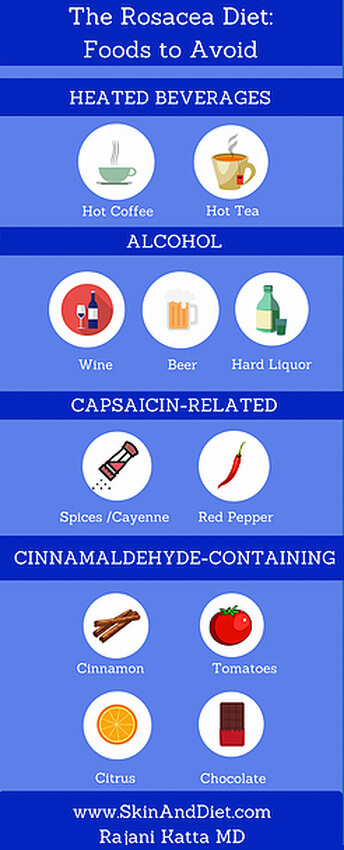 Pinpointing potential rosacea triggers can be challenging and may lead to a hard-to-remember list of seemingly incongruous foods like alcohol, chocolate, citrus and bell peppers. While these foods may seem disparate, there may be a logical explanation for why certain foods cause rosacea to flare, according to Dr. Rajani Katta, clinical assistant professor of medicine at Baylor College of Medicine and the author of Glow: The Dermatologist's Guide to a Whole Foods Younger Skin Diet.
Pinpointing potential rosacea triggers can be challenging and may lead to a hard-to-remember list of seemingly incongruous foods like alcohol, chocolate, citrus and bell peppers. While these foods may seem disparate, there may be a logical explanation for why certain foods cause rosacea to flare, according to Dr. Rajani Katta, clinical assistant professor of medicine at Baylor College of Medicine and the author of Glow: The Dermatologist's Guide to a Whole Foods Younger Skin Diet.
“Tomatoes, chocolate and citrus... what do these foods have in common?” asked Dr. Katta during a session at the American Academy of Dermatology summer meeting in Chicago. “They’re all known to be vasodilators because they all contain a substance called cinnamaldehyde.”
Dr. Katta groups rosacea dietary triggers into four categories: cinnamaldehyde-related, capsaicin-related, heat-related and alcohol-related. While heated beverages and alcohol may seem like obvious rosacea triggers, foods that contain capsaicin (peppers, spices and hot sauces) and cinnamaldehyde (cinnamon, chocolate, citrus and tomatoes) may be less obvious and more difficult to track and avoid. In addition to medical therapy, Dr. Katta suggested that patients should keep a food diary and undertake an eight-week elimination diet, individually adding potential triggers back into the diet slowly over time.
In addition to the foods that should be avoided, Dr. Katta recommended rosacea patients incorporate eating more probiotics (yogurt, kefir and fermented foods) and prebiotics (legumes, vegetables and whole grains), pointing to studies that found high comorbidity rates between gastrointestinal diseases and rosacea.
“There does appear to be a connection here, but we need to do more research to determine what that connection is,” said Dr. Katta in reference to gut and skin health.
Infographic courtesy of Dr. Rajani Katta.